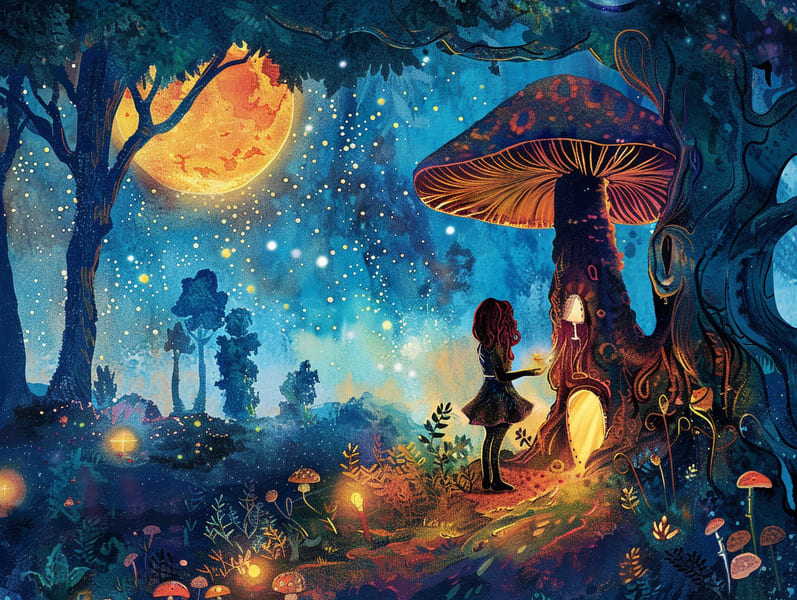
Old fairy tales have ancient roots. These tales have been recounted from one generation to the next centuries before they were ever put on paper. They originated from a variety of cultures, including Indigenous traditions. They were initially narrated among elders, often carrying themes and messages relevant to the societal norms and beliefs of the time.
The Grimm brothers, the two Grimm brothers, were among the first to compile and publish many of these beloved fairy tales. Their compilation, "Grimm's Children's Stories," included stories like "The True Bride," "The Story of Hansel and Gretel," and "Little Snow White," which have since become classics in the world of famous fairy tales. Similarly, H. C. Andersen's magical fairy tales, such as "The Mermaid's Tale," and "The Duckling's Story," have enchanted hearts worldwide, establishing their place in the pantheon of iconic fairy tales.
Despite their ancient origins, these tales remain as pertinent as ever, especially as nighttime stories for kids. These magical stories are now available in numerous formats, including beautifully illustrated books, captivating animations, and internet fairy tales.
Their lasting presence can be credited to several delightful features:
Important Morals: Classic fairy tales often convey important moral lessons. Stories like "The Wolf and the Liar" teach the benefit of sincerity, while "The Race of the Tortoise and the Hare" show the qualities of perseverance and unpretentiousness. These narratives offer kids clear distinctions between virtue and vice, developing their moral compass in a kind yet lasting way.
Sympathy and Perception: Ancient fairy tales frequently illustrate protagonists facing tests and troubles, fostering young listeners to empathize with their struggles and cheer for their triumphs. For instance, "Beauty and the Beast" demonstrates the significance of looking beyond appearances to realize the true nature of a person, promoting warmth and insight.
Cultural Understanding: Many traditional fairy tales are saturated in the cultural contexts from which they grew. Engaging with these narratives can provide captivating looks into different historical contexts, enhancing a sense of cultural respect and comprehension.
Imagination and Innovation: The enchanted elements in traditional fairy tales—talking beasts—activate children’s fantasies. These fairy tales move readers to imaginary realms, promoting inventive thinking and a sense of awe that lasts a lifetime.
Classic fairy tales are not only whimsical but also enlightening. They function as charming tools in building various cognitive and affective skills in little ones. When timeless fairy tales are voiced, they develop language skills by introducing new language items and elaborate sentence structures. This practice also promotes listening abilities and attentiveness, as kids keep up with the story, anxious to see what happens next.
Furthermore, discussing the themes and characters of ancient fairy tales can advance cognitive skills and intellectual skills. Young readers learn to pinpoint patterns, foresee events, and understand cause and effect. These discussions also contribute to children communicate their thoughts and feelings, promoting their emotional intelligence.
In today’s information age, the abundance of online fairy tales has made these tales more accessible than ever. Digital sites and software present comprehensive collections of bedtime fairy tales that can be experienced or listened via anytime, anywhere. Fairy tales told out loud are particularly favored, extending an charming way for young readers to engage with these captivating stories. Read-aloud stories and voiced videos carry characters and settings to life, often complemented by delightful soundtracks and music that heighten the narrative journey.
The persistent attraction of classic fairy tales lies in their ability to transform to today's world while preserving their key morals. Contemporary retellings of these fairy tales often bring in more different protagonists and modern settings, making them meaningful to today’s audience. However, the essential messages of guts, kindness, and fair-mindedness remain unchanged, continuing to influence readers of all ages.
Fairy tales also offer a sense of contentment and predictability. They disclose a organized narrative with a apparent beginning, middle, and end, often wrapping up with the finalization of conflicts and the triumph of virtue over vice. This reliability can be comforting for young ones, affording a sense of unwaveringness in an ever-changing world.
Ancient fairy tales continue to allure and enlighten new generations, maintaining their enchantment and value in modern society. As bedtime stories for kids, they afford a perfect blend of charm and understanding, facilitating moral values, empathy, and creativity. The accessibility of digital storybooks and the prevalence of fairy tales spoken validate that these classic stories remain obtainable to new more info generations.
By protecting and disseminating these stories, we continue to acknowledge the rich tapestry of narrative artistry and cultural heritage. Whether you are accessing a vibrantly illustrated book, experiencing a web collection, or listening through an voice book, the mystique of ancient fairy tales is always within reach. These tales reveal of the continued nature of narratives and its ability to gather us across generations and cultures.
Regardless if you are browsing a colorful picture book, seeing a online library, or listening on an audiobook, the spell of traditional fairy tales is always within reach.
These stories convey of the perpetual ability of tales and its ability to unify us across time and space, establishing a link that captivates and teaches alike.